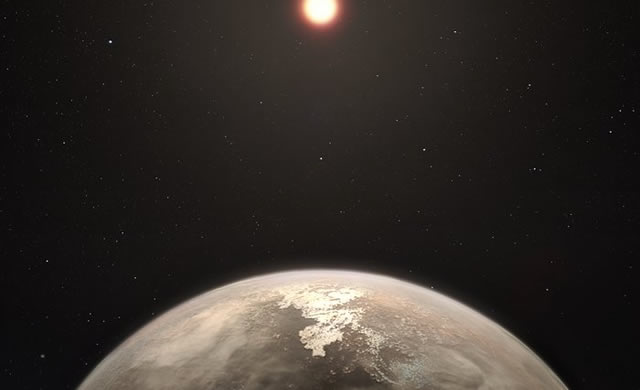 Credits: ESO/M. Kornmesser
Credits: ESO/M. Kornmesser
Scoperto il più vicino mondo con clima temperato in orbita intorno a una stella tranquilla – Lo strumento HARPS dell’ESO trova un esopianeta di massa terrestre intorno a Ross 128 – Un pianeta dal clima temperato, di dimensioni terrestri, è stato scoperto a soli 11 anni luce dal Sistema Solare da un’equipe di astronomi che ha utilizzato lo strumento HARPS, il famoso cercatore di pianeti. Il nuovo mondo è stato designato come Ross 128 b ed è il secondo pianeta più vicino dal clima temperato dopo Proxima b. È anche il pianeta più vicino scoperto in orbita intorno a una nana rossa non attiva: questo fatto potrebbe aumentare le probabilità che il pianeta possa sostenere la vita. Ross 128 b sarà uno dei principali bersagli dell’ELT (Extremely Large Telescope) dell’ESO, che sarà in grado di cercare biomarcatori nell’atmosfera del pianeta.
Un’equipe che ha utilizzato lo strumento HARPS (High Accuracy Radial velocity Planet Searcher) dell’ESO all’Osservatorio di La Silla in Cile ha scoperto che intorno alla nana rossa Ross 128 orbita, ogni 9,9 giorni, un esopianeta di piccola massa. Questo mondo di dimensioni terrestri dovrebbe avere un clima temperato, con una temperatura superficiale che potrebbe essere vicina a quella della Terra. Ross 128 è la più “tranquilla” delle stelle vicine a noi ad avere un esopianeta con queste condizioni. “La scoperta è basata sul monitoraggio intensivo con HARPS durato più di un decennio, insieme con tecniche di riduzione e analisi dati all’avanguardia. Solo HARPS ha dimostrato la precisione necessaria e continua a essere il miglior strumento per la misura di velocità radiali, 15 anni dopo l’inizio delle operazioni,” spiega Nicola Astudillo-Defru (Osservatorio di GInevra – Università di Ginevra, Svizzera), coatuore dell’articolo che presenta la scoperta. Le nane rosse sono tra le stelle più fredde, più deboli – e più comuni – dell’Universo, il che le rende ottimi obiettivi per la ricerca di esopianeti. Di conseguenza, sono sempre più studiate. Il primo autore Xavier Bonfils (Institut de Planétologie et d’Astrophysique de Grenoble – Université Grenoble-Alpes/CNRS, Grenoble, Francia) ha perciò chiamato il loro programma HARPS “La scorciatoia per la felicità”, perchè è più facile trovare gemelli della Terra, freddi e piccoli, intorno a queste stelle che intorno a stelle più simili al Sole. Molte nane rosse, tra cui Proxima Centauri, sono soggette a brillamenti che a volte inondano i loro pianeti di radiazioni UV e raggi X, mortali.
Sembra invece che Ross 128 sia una stella molto più quieta e ne consegue che i suoi pianeti potrebbero essere i più vicini candidati a ospitare la vita.
Anche se attualmente si trova a 11 anni luce dalla Terra, Ross 128 si sta muovendo nella nostra direzione e dovrebbe essere il nostro vicino più prossimo tra appena 79 000 anni – un batter d’occhio in termini cosmici. Ross 128 b strapperà dunque a Proxima b il primato dell’esopianeta più vicino alla Terra!
Fonte/Leggi tutto → ESO.org
ESO’s HARPS instrument finds Earth-mass exoplanet around Ross 128 – A temperate Earth-sized planet has been discovered only 11 light-years from the Solar System by a team using ESO’s unique planet-hunting HARPS instrument. The new world has the designation Ross 128 b and is now the second-closest temperate planet to be detected after Proxima b. It is also the closest planet to be discovered orbiting an inactive red dwarf star, which may increase the likelihood that this planet could potentially sustain life. Ross 128 b will be a prime target for ESO’s Extremely Large Telescope, which will be able to search for biomarkers in the planet’s atmosphere.
A team working with ESO’s High Accuracy Radial velocity Planet Searcher (HARPS) at the La Silla Observatory in Chile has found that the red dwarf star Ross 128 is orbited by a low-mass exoplanet every 9.9 days. This Earth-sized world is expected to be temperate, with a surface temperature that may also be close to that of the Earth. Ross 128 is the “quietest” nearby star to host such a temperate exoplanet. “This discovery is based on more than a decade of HARPS intensive monitoring together with state-of-the-art data reduction and analysis techniques. Only HARPS has demonstrated such a precision and it remains the best planet hunter of its kind, 15 years after it began operations,” explains Nicola Astudillo-Defru (Geneva Observatory – University of Geneva, Switzerland), who co-authored the discovery paper. Red dwarfs are some of the coolest, faintest — and most common — stars in the Universe. This makes them very good targets in the search for exoplanets and so they are increasingly being studied. In fact, lead author Xavier Bonfils (Institut de Planétologie et d’Astrophysique de Grenoble – Université Grenoble-Alpes/CNRS, Grenoble, France), named their HARPS programme The shortcut to happiness, as it is easier to detect small cool siblings of Earth around these stars, than around stars more similar to the Sun. Many red dwarf stars, including Proxima Centauri, are subject to flares that occasionally bathe their orbiting planets in deadly ultraviolet and X-ray radiation.
However, it seems that Ross 128 is a much quieter star, and so its planets may be the closest known comfortable abode for possible life.
Although it is currently 11 light-years from Earth, Ross 128 is moving towards us and is expected to become our nearest stellar neighbour in just 79 000 years — a blink of the eye in cosmic terms. Ross 128 b will by then take the crown from Proxima b and become the closest exoplanet to Earth!
Source/Continue reading → ESO.org





















